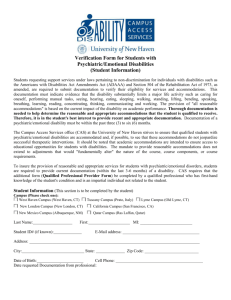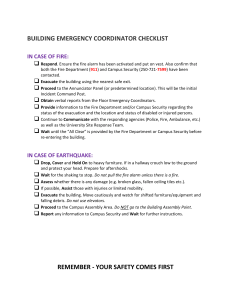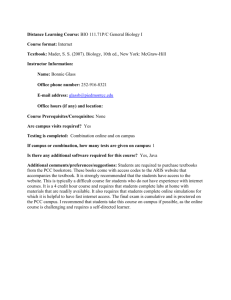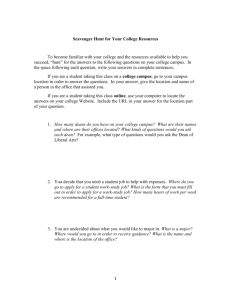A New Model for Access, 10(3) 1993.
advertisement
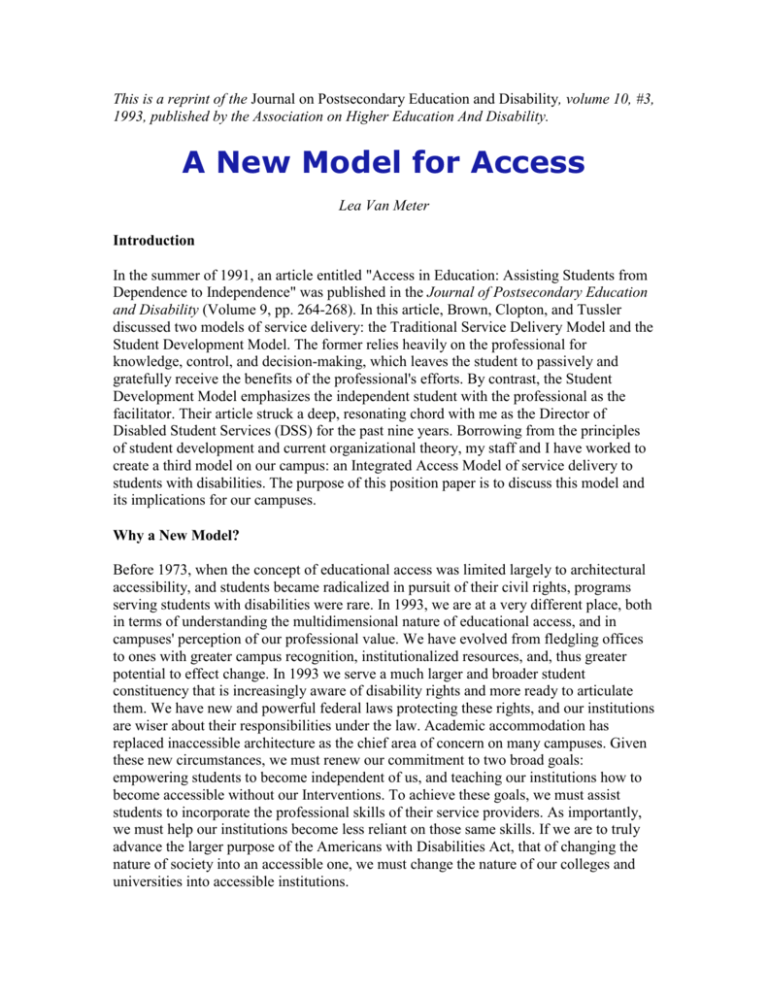
This is a reprint of the Journal on Postsecondary Education and Disability, volume 10, #3, 1993, published by the Association on Higher Education And Disability. A New Model for Access Lea Van Meter Introduction In the summer of 1991, an article entitled "Access in Education: Assisting Students from Dependence to Independence" was published in the Journal of Postsecondary Education and Disability (Volume 9, pp. 264-268). In this article, Brown, Clopton, and Tussler discussed two models of service delivery: the Traditional Service Delivery Model and the Student Development Model. The former relies heavily on the professional for knowledge, control, and decision-making, which leaves the student to passively and gratefully receive the benefits of the professional's efforts. By contrast, the Student Development Model emphasizes the independent student with the professional as the facilitator. Their article struck a deep, resonating chord with me as the Director of Disabled Student Services (DSS) for the past nine years. Borrowing from the principles of student development and current organizational theory, my staff and I have worked to create a third model on our campus: an Integrated Access Model of service delivery to students with disabilities. The purpose of this position paper is to discuss this model and its implications for our campuses. Why a New Model? Before 1973, when the concept of educational access was limited largely to architectural accessibility, and students became radicalized in pursuit of their civil rights, programs serving students with disabilities were rare. In 1993, we are at a very different place, both in terms of understanding the multidimensional nature of educational access, and in campuses' perception of our professional value. We have evolved from fledgling offices to ones with greater campus recognition, institutionalized resources, and, thus greater potential to effect change. In 1993 we serve a much larger and broader student constituency that is increasingly aware of disability rights and more ready to articulate them. We have new and powerful federal laws protecting these rights, and our institutions are wiser about their responsibilities under the law. Academic accommodation has replaced inaccessible architecture as the chief area of concern on many campuses. Given these new circumstances, we must renew our commitment to two broad goals: empowering students to become independent of us, and teaching our institutions how to become accessible without our Interventions. To achieve these goals, we must assist students to incorporate the professional skills of their service providers. As importantly, we must help our institutions become less reliant on those same skills. If we are to truly advance the larger purpose of the Americans with Disabilities Act, that of changing the nature of society into an accessible one, we must change the nature of our colleges and universities into accessible institutions. The Integrated Access Model The Integrated Access Model, which I propose, is in harmony with current organizational theory as articulated by Deming (1986), Peters (1992), and Bennis (1993 a & b). This newer theory stresses integrated, boundary-less forms in which each person is expected to be more knowledgeable about the whole, that is, more flexible. This theory moves away from earlier ones in which there were high levels of differentiation and specialization, where the whole picture was unclear to individuals, and where persons did not see their relationship to the entire organization. A theory that decentralizes expertise and enlarges each person's scope translates itself well into the Integrated Access Model wherein all institutional units and persons have knowledge and skills in accommodating students with disabilities. Making The Transition How can we move away from the Traditional Service Delivery Model, with an office for services to students with disabilities as its centerpiece, toward a model where the campus at large is empowered to assist students in meeting their own disability-related needs? How can we enlarge on the Student Development Model to create an institution where accommodation becomes an instinctive response to students' self-advocacy? Some specific rationales and suggestions toward that end are offered. Work to ensure that educational access to students with disabilities is viewed as the responsibility of the entire college or university, and not just that of one office. Students must receive appropriate and necessary assistance and accommodations from the department or person from whom they are receiving the service. For example, students needing large-print handouts and exams should expect that their professors routinely provide enlarged copies. Similarly, students having disability-related expenses should expect that their financial aid advisor will be able to utilize that information and professional judgment in order to fairly package that student's financial aid. Likewise, a computer center should expect to provide voice recognition software in order to accommodate a student's needs. Sharing information and sources of information should be the major role of the disabled student services staff; other offices should provide needed accommodation. Build a community of experts in order to accomplish this more undifferentiated knowledge and sensitivity base. Aggressively teaching (informing, sensitizing, and being a resource for) all campus units about appropriately responding to students' requests for accommodation is the essential task. On our campus, we have requested time on the agenda of faculty, administrators' and other staff meetings, conducted seminars during teaching assistant orientations, and planned a brown bag luncheon through our Center for Teaching, to which I invited faculty to address various disability-related topics. We look for ways to connect students with disabilities to the academic interests of faculty. For example, we helped to recruit hearing-impaired students for a senior faculty's research in speech-reading. To help students locate faculty role models, DSS hired a free-lance writer who interviewed faculty who have disabilities. Their stories will appear in a campus wide publication. Payment for writing these stories came from the Center for Teaching. Determine the most appropriate place for a service or accommodation to reside. Questions we need to ask: who should be responsible for providing a service? Who is already providing a similar service for other students? Who could provide the service with little modification to existing procedures? On our campus this is done through discussion among DSS staff, with the advice and counsel of its advisory committee made up of faculty, staff and students. For example, with adequate student notification, academic accommodations can be made directly by a faculty member, teaching assistant, or departmental staff with little or no intervention by an office specializing In services to students with disabilities. Using our campus as an example, the Office of Disabled Student Services had, for many years, arranged for special testing space, hired test proctors, and negotiated accommodations with faculty. Using the Integrated Access Model our staff determined that since testing is a faculty function, faculty and their staffs should be sensitized and given information so that they could provide necessary accommodation. Extensive groundwork was laid for these major policy and procedural changes. A draft letter introducing the changes and their potential benefits to both students and faculty was written by the Director of DSS to the Academic Vice Chancellor to be sent to faculty and their staff under his name. Meetings followed with the academic deans and academic departmental staff. Simple forms were generated by DSS to communicate the accommodations requested by the students and supported by DSS, and hand-carried to each faculty member by the student. Several conversations followed with individual professors who wanted clarification as mid-term examinations were underway. While this process seemed daunting and its outcome uncertain, the process went smoothly with few problems. Another example of the Integrated Access Model applies to transportation. DSS has, from its beginning, operated a van transportation system, using two lift-equipped vans to transport students needing adaptive transportation to all campus locations. In fall of 1993, the plan to relocate this modified demand-response paratransit system to the Office of Transportation Services (TSM) and integrate it with all campus transportation services is in progress. The transition will require training of new personnel currently unfamiliar with riders who have special needs, and the orientation of student users to any changes in service procedures the relocation will bring. The change will expand the information base of all TSM staff. Become politically involved with institutional policymaking and long-range planning decisions, and the effects those decisions might have on members of the campus community who have disabilities. Change the way the institution operates. Seek invitations to serve on critical campuswide planning and policy committees, providing your perspective on issues that may have an impact on students, faculty, and staff with disabilities. Our staff have requested and accepted invitations to serve on such important committees as that of a division-wide budget committee, campuswide transit oversight and transportation committees, as well as search committees for key campus personnel. Review existing campus policies to determine if an adverse effect on persons with disabilities exists. Recommend changes. Make initiatives. Build coalitions. Identify unmet needs. A survey of students, faculty and staff to determine the climate of campus accommodation is useful, opening the way to continued dialogue, Find others on your campus and in your community who can problem-solve, advocate, and find resources to meet the need. Join them. Lead them. Keep pressure on high-level campus administrators to state boldly policies regarding the accommodation of students with disabilities. Refer to those policies, and designate personnel responsible for implementing these policies. Two years ago, our office supported the campuswide change of policy leading to a smokefree campus. This year, with the approval of the campus Committee on Educational Policy and the support of our Registrar's Office, our campus codified and published campus policy requiring accommodation in examinations for students with verifiable disabilities. This policy assigns joint responsibility among DSS, faculty, and students for arranging accommodations. It also states that students may make those arrangements directly with their faculty. Assist students to become excellent self advocates. To begin this process, they must understand the implications of their disabilities in their academic lives, and their rights and responsibilities as persons with disabilities. Teach students how to be effective selfadvocates. These skills can be learned in a variety of situations: in one-on-one advising sessions, through role-play, analyzing their interactions on campus, and in workshops with students on such topics as problem-solving, working with complex bureaucracies, and dealing with difficult people. Students who have achieved these skills can teach other students. This year we are planning a jointly sponsored workshop with the Office of Ombudsman, Women's Center, and the Student Affirmative Action Office that will provide students with strategies to become more confident and resourceful selfadvocates. Conclusion Heretofore, we have looked toward building the resources of our programs in order to create access for students with disabilities. We have gained the expertise to serve them well. The next step is to share that expertise with our campus departments and strongly encourage them to use it to serve students and teach others. Adopting this focus will, for many offices serving students with disabilities, represent a shift from providing accommodation to teaching others how to accommodate. Doing this will require us to adjust our thinking from "us" as the experts and providers, to the notion that all campus personnel can become ready and able to meet the needs of students with disabilities. As we do this we expand the creativity and freshness of approach that others bring. Recognizing that although some campuses have more experience with the model which I have just described, every campus can look for new ways to incorporate its elements to a greater extent. As with all educational access programs, the goal is to create a campus environment where we are no longer necessary. References Deming, W. E. (1986). Out of crisis. Cambridge, MA: Cambridge University Press. Peters, T. (1992). Liberation management: necessary disorganization for the nanosecond nineties. New York: AA Knopf. Bennis, W. (1993a). An invented life: reflections on leadership and change. Reading, MA: Addison Wesley. Bennis, W. (1993b). Beyond bureaucracy. San Francisco, CA: Jossey-Bass.


